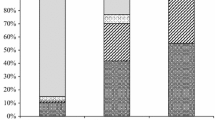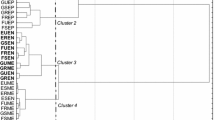Abstract
During fruit development, the concentration of main polyphenols (flavonols, flavanols, dihydrochalcones, hydroxycinnamic acids, anthocyanins) and the activities of related enzymes (phenylalanine ammonia lyase, chalcone synthase/chalcone isomerase, flavanone 3-hydroxylase, dihydroflavonol 4-reductase, flavonol synthase, peroxidase) were monitored in apple (Malus domestica Borkh.). The seasonal survey was performed at five different sampling dates and included the healthy peel of the resistant cultivar ‘Florina’ and healthy peel, scab symptomatic spot and the tissue around the infected spot of the susceptible cultivar ‘Golden Delicious’. From all enzymes tested, chalcone synthase/chalcone isomerase had the highest activity in both cultivars, while phenylalanine ammonia lyase had the lowest. The healthy peels of the susceptible and the resistant cultivar did not show differences in the accumulation of the main polyphenol groups present in the apple skin. However, in the resistant cultivar ‘Florina’, an increase of polyphenol enzyme activities could be observed in late stages of fruit development, which seems to be related to the anthocyanin accumulation in ripe fruits. Significant differences in the polyphenol metabolism were observed in the three different tissues of the susceptible cultivar ‘Golden Delicious’. Increased concentrations of hydroxycinnamic acids, dihydrochalcones and flavan-3-ols were found in the scab symptomatic spots and surrounding tissues. Phenylalanine ammonia-lyase, dihydroflavonol 4-reductase, flavanone 3-hydroxylase and peroxidase showed higher activities in the scab symptomatic spot compared to other analysed tissues, whereas the activities of other enzymes remained unchanged. Highest induction of polyphenol accumulation after scab infection was observed in early developmental stages, whereas enzyme activities were increased in later stages.





Similar content being viewed by others
References
Anand T, Bhaskaran R, Raguchander T, Samiyappan R, Prakasam V, Gopalakrishnan C (2009) Defence responses of chilli fruits to Colletotrichum capsici and Alternaria alternaria. Biol Plant 53:553–559
Bashir HA, Abu-Bakr A, Abu-Goukh A (2003) Composition changes during guava fruit ripening. Food Chem 80:557–563
Bazzi C, Messina C, Tortoreto L, Stefani E, Bini F, Brunelli A, Andreotti C, Sabatini E, Spinelli F, Costa G, Hauptmann S, Stammler G, Doerr S, Marr J, Rademacher W (2003) Control of pathogen incidence in pome fruits and other horticultural crop plants with prohexadione-Ca. Eur J Hortic Sci 68:108–114
Bors W, Michel C (2002) Chemistry of the antioxidant effect of polyphenols. Ann NY Acad Sci USA 957:57–69
Boss PK, Davies C, Robinson SP (1996) Expression of anthocyanin biosynthesis pathway genes in red and white grapes. Plant Mol Biol 32:565–569
Bruce RJ, West CA (1989) Elicitation of lignin biosynthesis and isoperoxidase activity by pectic fragments in suspension cultures of castor bean. Plant Physiol 91:889–897
Cheng GW, Breen PJ (1991) Activity of phenylalanine ammonia-lyase (PAL) and concentrations of anthocyanins and phenolics in developing strawbery fruit. J Am Soc Hort Sci 116:865–869
Dixon R, Paiva N (1995) Stress-induced phenylpropanoid metabolism. Plant Cell 7:1085–1097
Dixon RA, Xie DY, Sharma SB (2004) Proathocyanidins—a final frontier in flavonoid research? New Phytol 165:9–28
Fischer TC, Halbwirth H, Meisel B, Stich K, Forkmann G (2003) Molecular cloning, substrate specificity of the functionally expressed dihydroflavanol 4-reductases from Malus domestica and Pyrus comunis cultivars and the consequences for flavonoid metabolism. Arch Biochem Biophys 412:223–230
Forkmann G, Heller W (1999) Biosynthesis of flavonoids. In: Barton D, Nakanishi K, Meth-Cohn O (eds) Comprehensive natural products chemistry. Elsevier, Oxford, pp 713–748
Fuenfgelder S, Mayr U, Treutter D, Feucht W (1994) The activity of phenylalanine ammonia-lyase in apple leaves after wounding. Acta Horticulturae 381 International Symposium on Natural Phenols in Plant Resistance, vol. 2, pp 474–478
Gessler C, Pertot I (2011) The Vf apple scab resistance (this issue)
Gosch C, Halbwirth H, Kuhn J, Milosic S, Stich K (2009) Biosynthesis of phloridzin in apple (Malus domestica Borkh.). Plant Sci 176:223–231
Gosch C, Halbwirth H, Stich K (2010) Phloridzin: biosynthesis, distribution and physiological relevance in plants. Phytochemistry 71:838–843
Graham MY, Graham TL (1991) Rapid accumulation of anionic peroxidises and phenolic polymers in soybean coteledon tissues following treatments with Phytophtora megasperma F. sp. Glycinea wall glucan. Plant Physiol 97:1445–1455
Halbwirth H, Puhl I, Haas U, Jezik K, Treutter D, Stich K (2006) Two-phase flavonoid formation in developing strawberry (Fragaria × ananassa) fruit. J Agr Food Chem 54:1479–1485
Halbwirth H, Waldner I, Miosic S, Ibanez M, Costa G, Stich K (2009) Measuring flavonoid enzyme activities in tissues of fruit species. J Agr Food Chem 57:4983–4987
Harborne JB, Williams CA (2000) Advances in flavonoid research since 1992. Phytochemistry 55:481–504
Hrazdina G, Borejsza-Wysocki W, Lester C (1997) Phytoalexin production in an apple cultivar resistant to Venturia inaequalis. Phytopathology 87:868–876
Lata B, Trampczynska A, Paczesna J (2009) Cultivar variation in apple peel and whole fruit phenolic composition. Sci Hortic 121:176–181
Leser C, Treutter D (2005) Efects of nitrogen supply on growth, contents of phenolic compounds and pathogen (scab) resistance of apple trees. Physiol Plant 123:49–56
Lister CE, Lancaster JE, Sutton KH, Walker JRL (1994) Developmental changes in the concentration and composition of flavanoids in skin of red and green apple cultivar. J Sci Food Agr 64:155–161
MacHardy WE (1996) Apple scab, biology, epidemiology, and management. APS St Paul Minn, USA
Marks SC, Mullen W, Crozier A (2007) Flavonoid and chlorogenic acid profiles of English cider apples. J Sci Food Agr 87:719–728
Mayr U, Treutter D, Santos-Buelga C, Bauer H, Feucht W (1995) Developmental changes in the phenol concentrations of ‘golden delicious’ apple fruits and leaves. Phytochemistry 38:1151–1155
Mayr U, Michalek S, Treutter D, Feucht W (1997) Phenolic compounds of apple and their relationship to scab resistance. J Phytopathol 145:69–75
Michalek S, Mayr U, Treutter D, Lux-Endrich A, Gutmann M, Feucht W, Geibel M (1999) Role of flavan-3-ols in resistance of apple trees to Venturia inaequalis. Acta Hortic 484:535–539
Mikulic Petkovsek M, Stampar F, Veberic R (2007) Parameters of inner quality of the apple scab resistant and susceptible apple cultivars (Malus domestica Borkh.). Sci hort 114:37–44
Mikulic Petkovsek M, Stampar F, Veberic R (2009) Accumulation of phenolic compounds in apple in response to infection by the scab pathogen Venturia inaequalis. Physiol Mol Plant Pathol 74:60–67
Picinelli A, Dapena E, Mangas JJ (1995) Polyphenolic pattern in apple tree leaves in relation to scab resistance: a preliminary study. J Agr Food Chem 43:2273–2278
Sandermann H, Strominger L (1972) Purification and properties of C55—isoprenoid alcohol phosphokinase from Staphylococcus aureus. J Biol Chem 247:5123–5131
Saure MC (1990) External control of anthocyanin formation in apple. Sci hort 42:181–218
Slatnar A, Mikulic Petkovsek M, Halbwirth H, Stampar F, Stich K, Veberic R (2010a) Enzyme activity of the phenylpropanoid pathway as a response to apple scab (Venturia ineaqualis (Cooke) G. Wint.) infection. Ann Appl Biol 156:449–456
Slatnar A, Mikulic Petkovsek M, Halbwirth H, Stampar F, Stich K, Veberic R (2010b) Response of phenylpropanoid pathway to Venturia inaequalis infection in the maturing fruit of ‘Braeburn’ apple. J Hortic Sci Biotech 85:465–472
Treutter D (2001) Biosynthesis of phenolic compounds and its regulation in apple. Plant Growth Regul 34:71–89
Treutter D (2005) Significance of flavonoids in plant resistance and enhancement of their biosynthesis. Plant Biol 7:581–591
Treutter D (2010) Managing phenol contents in crop plants by phytochemical farming and breeding. Int J Mo Sci 11:807–857
Treutter D, Feucht W (1990a) The pattern of flavan-3-ols in relation to scab resistance of apple cultivars. J Hortic Sci 65:511–517
Treutter D, Feucht W (1990b) Accumulation of flavan-3-ols in fungus-infected leaves of Rosaceae. Z Pflanzenkr Pflanzenpathol Pflanzenschutz 97:634–641
Vidhyasekaran P (1997) Fungal pathogenesis in plants and crops: molecular biology and host defence mechanisms. Marcel Dekkler, New York
Walter MH (1992) Regulation of lignification in defence. In: Boller T, Meins F (eds) Genes involved in plant defences. Springer, New York, pp 327–352
Worthington Biochemical Corporation (1972) The Worthington manual. Freehold, New York, p 1943
Acknowledgments
This work is part of the programme Horticulture No. P4-0013-0481 and the project No. J4-0890 funded by the Slovenian Research Agency. Ana Slatnar was supported by COST 864 (COST-STSM-864-05258). H. Halbwirth acknowledges her grant from the Austrian FWF (Project V18-B03). This work was performed within the frame of COST 864.
Author information
Authors and Affiliations
Corresponding author
Additional information
Communicated by D. Treutter.
Rights and permissions
About this article
Cite this article
Slatnar, A., Mikulic Petkovsek, M., Halbwirth, H. et al. Polyphenol metabolism of developing apple skin of a scab resistant and a susceptible apple cultivar. Trees 26, 109–119 (2012). https://doi.org/10.1007/s00468-011-0577-3
Received:
Revised:
Accepted:
Published:
Issue Date:
DOI: https://doi.org/10.1007/s00468-011-0577-3




